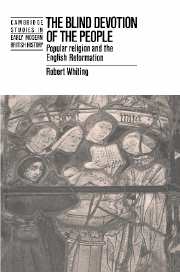Book contents
- Frontmatter
- Contents
- List of illustrations
- Preface
- Note
- 1 Introduction
- 2 Survey
- PART ONE ASSESSMENT
- PART TWO EXPLANATION
- 8 Spiritual motivations: Lutheranism, Calvinism and other faiths
- 9 Non-spiritual motivations: politics, economics and other forces
- 10 Mediate influences: literature, drama and art
- 11 Immediate influences: example, action and oral communication
- 12 Summation of Part Two
- 13 Perspective
- Appendix 1 Maps
- Appendix 2 Graphs
- Bibliography and abbreviations
- Index
12 - Summation of Part Two
Published online by Cambridge University Press: 11 December 2009
- Frontmatter
- Contents
- List of illustrations
- Preface
- Note
- 1 Introduction
- 2 Survey
- PART ONE ASSESSMENT
- PART TWO EXPLANATION
- 8 Spiritual motivations: Lutheranism, Calvinism and other faiths
- 9 Non-spiritual motivations: politics, economics and other forces
- 10 Mediate influences: literature, drama and art
- 11 Immediate influences: example, action and oral communication
- 12 Summation of Part Two
- 13 Perspective
- Appendix 1 Maps
- Appendix 2 Graphs
- Bibliography and abbreviations
- Index
Summary
How is the decline of popular Catholicism to be explained?
Only in part is the phenomenon attributable to an upsurge of alternative Christian convictions. The evidence suggests that before 1570 no more than a relatively small minority of south-western people were committed Protestants. Nor was their Protestantism wholly uniform. Episcopacy, for example, was accepted by Thomas Bennett but derided by Philip Gammon, while during their Genevan exile John Budleigh and Peter Willis participated as senior and deacon in a presbyterian form of organization. Infant baptism was supported by Philip Nichols but rejected by Philip Gammon. Agnes Priest was labelled by the ecclesiastical authorities as an ‘Anabaptist’, and Philip Gammon's alleged repudiation of Christ's virgin birth would certainly locate him outside the mainstream of Protestant belief. For the majority of the region's inhabitants, in contrast, acquiescence or co-operation in the assault upon traditional religion was motivated by essentially non-spiritual considerations. Protestant conviction was less important than a sense of duty, xenophobia, a desire for moral freedom, financial calculation, or even physical fear.
The overall pattern again contained significant variations. In terms of geography, for instance, Protestant commitment was markedly more evident in Devon than in Cornwall. ‘Devonshire’, declared Philip Nichols in 1547, ‘lacketh not some well-willers, at the least … that desire the glory of God and furtherance of his word.’ Of the region's identifiable non-gentle lay Protestants, most were in fact Devonian; the exiles in this category, for example, were exclusively from Devon.
- Type
- Chapter
- Information
- The Blind Devotion of the PeoplePopular Religion and the English Reformation, pp. 259 - 261Publisher: Cambridge University PressPrint publication year: 1989



